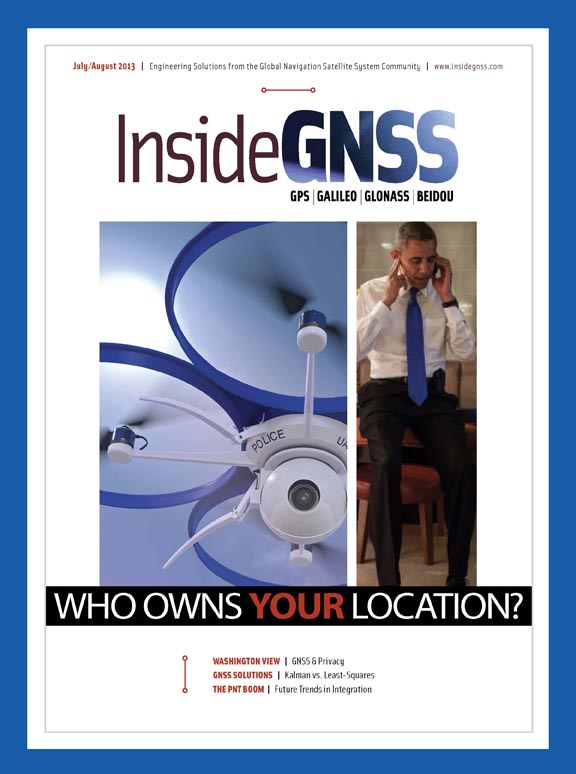To advertise, contact gl**@********ss.com
Ad materials due: January 12
This issue ships directly from the printer to the ION International Technical Meeting for the January 26 show in Anaheim, California. Inside GNSS editor Glen Gibbons will be at the sessions and on the floor.
This issue will also be available at: GPS Wireless 2009, San Francisco, February 4-5 and Munich Satellite Navigation Summit, Munich, Germany, March 3-5
To advertise, contact gl**@********ss.com
Ad materials due: January 12
This issue ships directly from the printer to the ION International Technical Meeting for the January 26 show in Anaheim, California. Inside GNSS editor Glen Gibbons will be at the sessions and on the floor.
This issue will also be available at: GPS Wireless 2009, San Francisco, February 4-5 and Munich Satellite Navigation Summit, Munich, Germany, March 3-5
COVER STORY
GPS and Regime Change, Part II: What Lies Ahead
Glen Gibbons
In November-December 2008, Part I focused on key changes in the GPS program during the Bush administration during the past eight years. The second part of this series examines the prospects for the system under the in-coming presidency of Barack Obama. (Read GPS and Regime Change, Part I: The Bush Legacy)
TECHNICAL ARTICLES
Autonomous Integrity: An Error Isotropy-based Approach
Miguel Azaola-Sáenz and Joaquín Cosmen-Schortmann, GMV
Several recent Inside GNSS articles cover techniques to ensure GNSS integrity for civil aviation and other safety-of-life applications. Unlike the measurement-rejection approach of many receiver autonomous integrity monitoring (RAIM) techniques, however, this article introduces an error isotropy–based error-characterization technique for computing protection levels. The new approach was developed in the framework of "liability-critical" applications — those in which undetected, large GNSS position errors create serious legal or economic consequences. It also may provide a simple and robust solution to the multi-constellation integrity problem, significantly simplifying the requirements and design of ground-segment integrity monitoring facilities.
QZSS’s Indoor Messaging System: GNSS Friend or Foe?
Andrew Dempster, Satellite Navigation and Positioning Laboratory, University of New South Wales, Australia
A lesser-known feature of Japan’s Quasi-Zenith Satellite System (QZSS) program is its IMES or Indoor Messaging System, which uses pseudorandom noise codes (PRNs) and operates in the GPS L1 frequency. The Japan Aerospace Exploration Agency (JAXA) designed the IMES signal to contribute to development of QZSS-ready receivers as well as satellite positioning applications by supporting development of seamless indoor/outdoor positioning. Based on a review of the IMES interface specification and presentations of initial simulation and text results, the author explores whether IMES is the perfect answer for“seamless” ubiquitous positioning or a serious jamming threat to the integrity of GPS.
GNSS WORLD
ICG Journey: The International Committee on GNSS Searches for Common Ground
After accentuating the positive in its first two meetings, the third gathering of the UN-supported ICG revealed just how far the world’s GNSS providers have to go to make their systems (and augmentations) compatible and interoperable. A report from December’s ICG-3 meeting in Pasadena, California.
WORKING PAPERS
GNSS in Space: Formation Flying Radio Frequency Techniques and Technology, Part 2
with CNES, ESA, Thales Alenia Space, and GMV authors
In the November-December issue, Part I described the upcoming scientific missions that fly two or more smaller satellites in close formation to create large spaceborne instruments. In Part II, the authors explain how GNSS is used to achieve very accurate relative positioning and orientation of the spacecraft at lower altitudes and the similar approach used at higher altitudes for relative positioning by means of RF carrier phase measurement techniques. (Read GNSS in Space: Part I)
GNSS SOLUTIONS
This issue, we answer the questions: “What is the effect of GPS jamming on maritime safety?” Solution by Alan Grant and Paul Williams, General Lighthouse Authorities of the United Kingdom and Ireland. “What are linear carrier phase combinations and what are the relevant considerations?” Solution by Mark Petovello, University of Calgary
Plus the GNSS news in "360 Degrees," data points to amuse and inform in "GNSS Hotspots," the "Industry View" in that eponymous section, and new products in "GNSS Inside."




